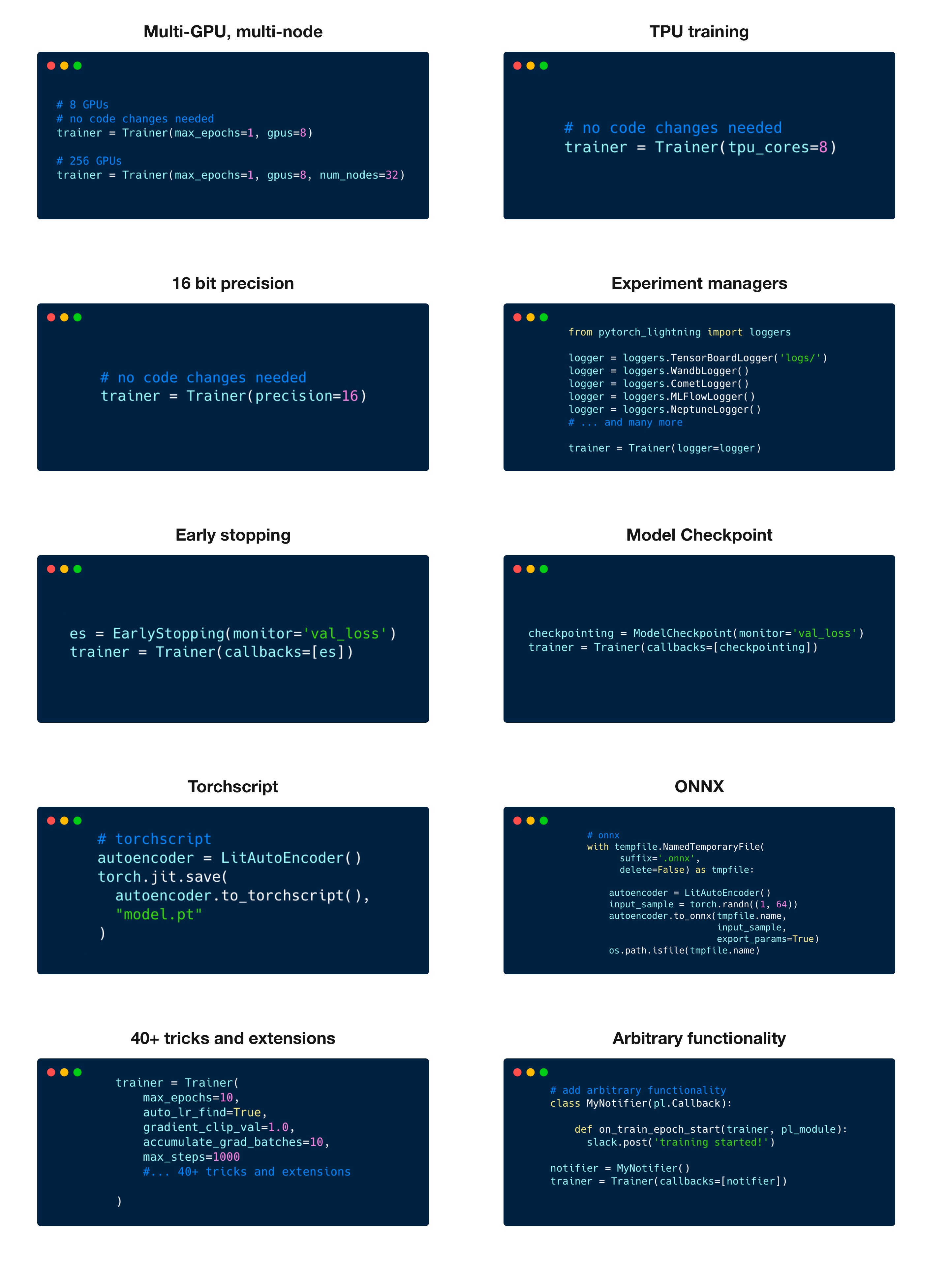NEWS: PyTorch Lightning has been renamed Lightning!

Deep learning framework to train, deploy, and ship AI products Lightning fast.
Lightning Gallery • Key Features • How To Use • Docs • Examples • Community • Contribute • License
Lightning disentangles PyTorch code to decouple the science from the engineering. 
Once you're done building models, publish a paper demo or build a full production end-to-end ML system with Lightning Apps. Lightning Apps remove the cloud infrastructure boilerplate so you can focus on solving the research or business problems. Lightning Apps can run on the Lightning Cloud, your own cluster or a private cloud.
Browse available Lightning apps here
Lightning structures PyTorch code with these principles:
Lightning forces the following structure to your code which makes it reusable and shareable:
- Research code (the LightningModule).
- Engineering code (you delete, and is handled by the Trainer).
- Non-essential research code (logging, etc... this goes in Callbacks).
- Data (use PyTorch DataLoaders or organize them into a LightningDataModule).
Once you do this, you can train on multiple-GPUs, TPUs, CPUs and even in 16-bit precision without changing your code!
Get started in just 15 minutes
Lightning is rigorously tested across multiple CPUs, GPUs, TPUs, IPUs, and HPUs and against major Python and PyTorch versions.
Current build statuses
| System / PyTorch ver. | 1.10 | 1.12 |
|---|---|---|
| Linux py3.7 [GPUs**] | - | - |
| Linux py3.7 [TPUs***] | - | - |
| Linux py3.8 [IPUs] | - | - |
| Linux py3.8 [HPUs] | - | |
| Linux py3.{7,9} | - | |
| OSX py3.{7,9} | - | |
| Windows py3.{7,9} | - |
- ** tests run on two NVIDIA P100
- *** tests run on Google GKE TPUv2/3. TPU py3.7 means we support Colab and Kaggle env.
Simple installation from PyPI
pip install pytorch-lightningOther installation options
pip install pytorch-lightning['extra']conda install pytorch-lightning -c conda-forgeInstall future release from the source
pip install https://github.com/Lightning-AI/lightning/archive/refs/heads/release/stable.zip -UInstall nightly from the source (no guarantees)
pip install https://github.com/Lightning-AI/lightning/archive/refs/heads/master.zip -Uor from testing PyPI
pip install -iU https://test.pypi.org/simple/ pytorch-lightningimport os import torch from torch import nn import torch.nn.functional as F from torchvision.datasets import MNIST from torch.utils.data import DataLoader, random_split from torchvision import transforms import pytorch_lightning as plA LightningModule defines a full system (ie: a GAN, autoencoder, BERT or a simple Image Classifier).
class LitAutoEncoder(pl.LightningModule): def __init__(self): super().__init__() self.encoder = nn.Sequential(nn.Linear(28 * 28, 128), nn.ReLU(), nn.Linear(128, 3)) self.decoder = nn.Sequential(nn.Linear(3, 128), nn.ReLU(), nn.Linear(128, 28 * 28)) def forward(self, x): # in lightning, forward defines the prediction/inference actions embedding = self.encoder(x) return embedding def training_step(self, batch, batch_idx): # training_step defines the train loop. It is independent of forward x, y = batch x = x.view(x.size(0), -1) z = self.encoder(x) x_hat = self.decoder(z) loss = F.mse_loss(x_hat, x) self.log("train_loss", loss) return loss def configure_optimizers(self): optimizer = torch.optim.Adam(self.parameters(), lr=1e-3) return optimizerNote: Training_step defines the training loop. Forward defines how the LightningModule behaves during inference/prediction.
dataset = MNIST(os.getcwd(), download=True, transform=transforms.ToTensor()) train, val = random_split(dataset, [55000, 5000]) autoencoder = LitAutoEncoder() trainer = pl.Trainer() trainer.fit(autoencoder, DataLoader(train), DataLoader(val))Lightning has over 40+ advanced features designed for professional AI research at scale.
Here are some examples:
Highlighted feature code snippets
# 8 GPUs # no code changes needed trainer = Trainer(max_epochs=1, accelerator="gpu", devices=8) # 256 GPUs trainer = Trainer(max_epochs=1, accelerator="gpu", devices=8, num_nodes=32)Train on TPUs without code changes
# no code changes needed trainer = Trainer(accelerator="tpu", devices=8)16-bit precision
# no code changes needed trainer = Trainer(precision=16)Experiment managers
from pytorch_lightning import loggers # tensorboard trainer = Trainer(logger=TensorBoardLogger("logs/")) # weights and biases trainer = Trainer(logger=loggers.WandbLogger()) # comet trainer = Trainer(logger=loggers.CometLogger()) # mlflow trainer = Trainer(logger=loggers.MLFlowLogger()) # neptune trainer = Trainer(logger=loggers.NeptuneLogger()) # ... and dozens moreEarlyStopping
es = EarlyStopping(monitor="val_loss") trainer = Trainer(callbacks=[es])Checkpointing
checkpointing = ModelCheckpoint(monitor="val_loss") trainer = Trainer(callbacks=[checkpointing])Export to torchscript (JIT) (production use)
# torchscript autoencoder = LitAutoEncoder() torch.jit.save(autoencoder.to_torchscript(), "model.pt")Export to ONNX (production use)
# onnx with tempfile.NamedTemporaryFile(suffix=".onnx", delete=False) as tmpfile: autoencoder = LitAutoEncoder() input_sample = torch.randn((1, 64)) autoencoder.to_onnx(tmpfile.name, input_sample, export_params=True) os.path.isfile(tmpfile.name)For complex/professional level work, you have optional full control of the optimizers.
class LitAutoEncoder(pl.LightningModule): def __init__(self): super().__init__() self.automatic_optimization = False def training_step(self, batch, batch_idx): # access your optimizers with use_pl_optimizer=False. Default is True opt_a, opt_b = self.optimizers(use_pl_optimizer=True) loss_a = ... self.manual_backward(loss_a, opt_a) opt_a.step() opt_a.zero_grad() loss_b = ... self.manual_backward(loss_b, opt_b, retain_graph=True) self.manual_backward(loss_b, opt_b) opt_b.step() opt_b.zero_grad()- Models become hardware agnostic
- Code is clear to read because engineering code is abstracted away
- Easier to reproduce
- Make fewer mistakes because lightning handles the tricky engineering
- Keeps all the flexibility (LightningModules are still PyTorch modules), but removes a ton of boilerplate
- Lightning has dozens of integrations with popular machine learning tools.
- Tested rigorously with every new PR. We test every combination of PyTorch and Python supported versions, every OS, multi GPUs and even TPUs.
- Minimal running speed overhead (about 300 ms per epoch compared with pure PyTorch).
The lightning community is maintained by
- 10+ core contributors who are all a mix of professional engineers, Research Scientists, and Ph.D. students from top AI labs.
- 590+ active community contributors.
Want to help us build Lightning and reduce boilerplate for thousands of researchers? Learn how to make your first contribution here
Lightning is also part of the PyTorch ecosystem which requires projects to have solid testing, documentation and support.
If you have any questions please:







